Why Worry About Wildlife
Yet one more good reason from the Natural Resources Defense Council about why we should work to preserve all forms of life from extinction:
Yet one more good reason from the Natural Resources Defense Council about why we should work to preserve all forms of life from extinction:
by Todos Santos Eco Adventures
The California Sea Lion (Zalophus californianus) is one of the most sociable and fun-loving marine mammals around, and they love to congregate in large colonies of one thousand or more along the Pacific coastline. They are called the lions of the sea because of the loud roars they can produce. The males of some sea lion species also grow thick manes around their necks. From Todos Santos you can visit and interact with sea lions at the famous sea lion colony of Los Islotes in the Sea of Cortez.
Baby sea lions are usually born in late June and are fairly well-developed from day one. Just after birth they can swim a little bit, call for their mothers, and open their eyes. Several days after birth the sea lion mothers leave their youngsters in the rookery and head into the ocean in search of food. When they return they call for their babies with a loud trumpeting noise and the babies reply in a series of bleats. This goes on until mother and pup are reunited. The mother’s final test to determine that she has found her pup is to sniff the pup all over.
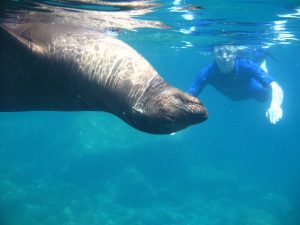
Getting to Know the Neighbors: Snorkeler & Sea Lion
Sea lion males are quite impressive in size (and seem especially so when you’re snorkeling nearby), growing up to 8 feet long and 660 pounds. Females are much smaller although they are still the size of a large man, growing up to 6.5 feet long and weighing in at over 200 pounds. As they mature, males grow a crest of bone on the top of their heads, and it is this crest that gives the sea lion its generic name: loph is forehead and za in an emphatic, so Zalophus californianus means “Californian big-head”.
The main difference between a sea lion and a seal in appearance is that sea lions actually have ears, while seals do not. Sea lions are also built to move on both land and water, although they definitely look more graceful in the ocean! The sea lion’s front flippers have a bone structure that is quite similar to that of a human arm and hand. These front flippers propel a sea lion forward while it is swimming, while the rear flippers control steering. The sea lions use both pairs of flippers to walk (waddle) on land.
California sea lions enjoy a wide variety of seafood and feed mainly on squid and fish. Adult females forage for food anywhere between 10 and 3,000 kilometers from the rookery and can dive as deep as 274 meters, with average dives of 31 to 98 meters. Sea lions can stay underwater for up to 15 minutes by sealing their noses shut. The Californian big-head lives to be about 17 in the wild, somewhat longer in captivity.
by Todos Santos Eco Adventures
The ancient Aztecs – the first documented avocado eaters – reputedly used the fruit as a sexual stimulant and called the avocado tree ahuacuatl, or testicle tree. While folks today largely attribute this name to the way the fruits dangle low on the tree – and often in pairs – the Aztecs may really have been on to something. In a study conducted by the California Avocado Commission, 63% of the expert psychologists, nutritionists and scientists surveyed considered the avocado an aphrodisiac, and 60% of respondents said that they knew of specific cases in which a person’s love life had improved after consuming the yummy fruit. As if we needed more reasons to break out the guacamole!
Modern science gives us an indication that the Aztec’s take on the avocado vis-a-vis amor may have been spot on. Avocados have a very high concentration of nutrients that are key to sexual health, including Vitamin E (sometimes known as the “sex vitamin” as it promotes the production of sex hormones which support attraction, mood and desire), beta carotene and magnesium. An avocado also has 2.4 grams of protein for every 1/2 cup of fruit – essential for any exercise – and packs more potassium than a banana.
For you word buffs out there, the Aztec word ahuacuatl morphed into the Spanish word aguacate which became avocado in the US. But no matter who called it what, the fruit’s amorous association stayed with it through the centuries, so much so that in the 1920s an American avocado advertising campaign denied the fruit’s aphrodisiac properties to tempt people into trying what sounded like very risque fare. The reverse psychology worked spectacularly and avocados became a coveted commodity.
Todos Santos has large numbers of avocado trees and our many fine restaurants know how to use the fruit to splendid effect in their savory fare. So come on down to enjoy the sun, enjoy the surf and enjoy the avocados! What? Don’t like avocados? Never fear – we have excellent strawberries too!
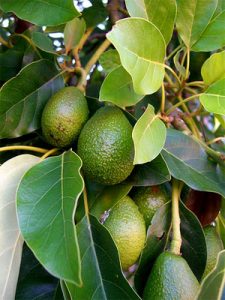
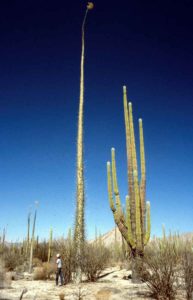
The Cirio Plant of Baja
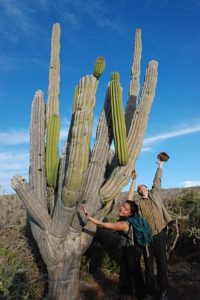
Cardon Cactus in the Baja Desert
by Todos Santos Eco Adventures
Approximately 23% of plants on the Baja peninsula are endemic to the area, including the ubiquitous Cardón Cactus. The cardón is one of the most massive of all cacti – it can weigh up to 25 tons and grow as tall as 18 meters (60 feet), although 10 meters (33 feet) is the average. It is a slow growing plant with a life span measured in hundreds of years. In fact, it is not until a cardón reaches about 80 years of age that it will start producing side branches. It is not unusual for a cardón to have as many as 25 vertical branches, each up to 1.5 meters / 5 feet in diameter, and, in older plants, typically taller than the trunk.
Another endemic plant that grows to a ripe old age in the Baja desert has been termed “one of the wackiest looking plants in the whole wide world,” and if you’ve ever driven between Todos Santos and Ensenada, chances are you’ve seen these groves of Cirio Plants. Looking like something straight from the imagination of Dr. Seuss, Cirios resemble nothing so much as giant, inverted carrots with spiny branches all over. The Spanish named them Cirio plants after the tall wax candles used in their churches, and subsequent visitors dubbed them Boojum Trees, a name taken from Lewis Carroll’s poem, The Hunting of the Snark. Whatever you call them they are definitely wild looking things that grow to great heights – between 60 and 90 feet – vying with the Cardón Cactus for the title of Tallest Plant in Baja. Because of this height, Boojum trees are great places to spot Baja’s predatory birds, who use the height advantage of the plant to spot pray as well as to nest in safety. Also like the Cardón, Boojum trees can live for centuries. It takes them about 27 years to grow one meter, which means that some of the taller specimens you see are up to 500 years old. So next time you’re out walking among our enormous desert plants, consider that they might have been seedlings when the conquistadores arrived.
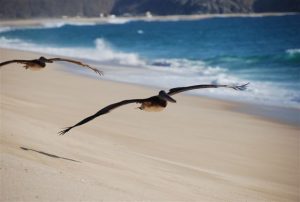
Pelicans Over La Poza Beach
by Todos Santos Eco Adventures
A wonderful bird is a pelican,
His bill will hold more than his belican.
He can take in his beak
Food enough for a week;
But I’m damned if I see how the helican.
By Dixon Lanire Merritt, 1910
The brown pelican is one of the best fishermen in Baja and watching these prehistoric-looking birds in action is pretty incredible. It is the only pelican species to dive for prey, zooming in from a height of 30 feet and streamlining its body and wings as it flings itself into the ocean like an arrow. The big beak pouch for which the pelican is so famous is used as a dip net to catch fish. But fish don’t stay there long – they are quickly transferred to the stomach (the center of gravity) so that the pelican can maintain balance while flying. Quick transference also helps prevent the likelihood that a gull will steal the fish, something that can happen if the pelican doesn’t swallow quickly enough. The brown pelican’s beak is capable of holding up to 3 gallons of water – about 3 times more than its belly can!
The Brown Pelican (Pelecanus occidentalis) is the smallest of the eight species of pelican, although it is a large bird in nearly every other regard. It is 106-137 cm (42-54 in) in length, weighs from 2.75 to 5.5 kg (6-12 lb) and has a wingspan from 1.83 to 2.5 m (6 to 8.2 ft). The brown pelican’s habit of diving for fish from the air distinguishes it from other pelican species that engage in cooperative fishing from the surface. Watching a flock of brown pelicans flying low over the ocean in V-formation is one of the majestic sights of Baja. They can fly at speed upwards of 30 miles per hour.
Fossil evidence tells us that pelicans have changed very little over the last 30 to 40 million years, perhaps accounting for their rather prehistoric look. Brown pelicans are hatched in broods of 2 to 3, and eat about 150 pounds of fish in the 8-10 month period they are cared for by their parents. Pelicans can live for up to 30 years.
© Copyright Sergio and Bryan Jauregui, Casa Payaso S de RL de CV, 2012